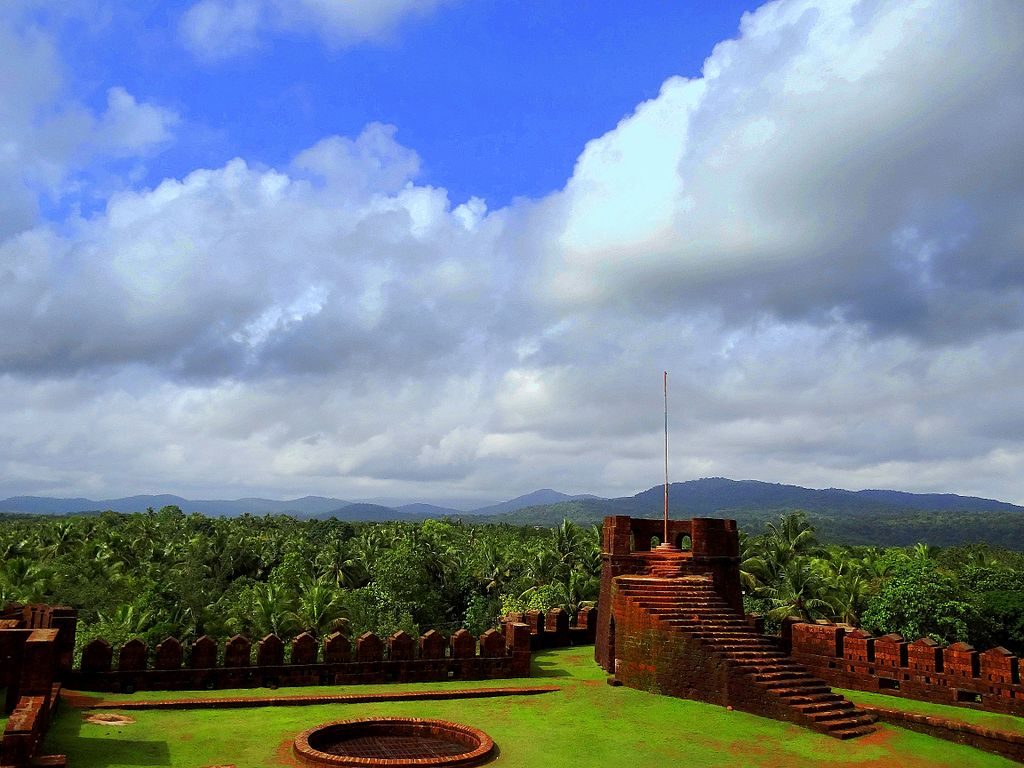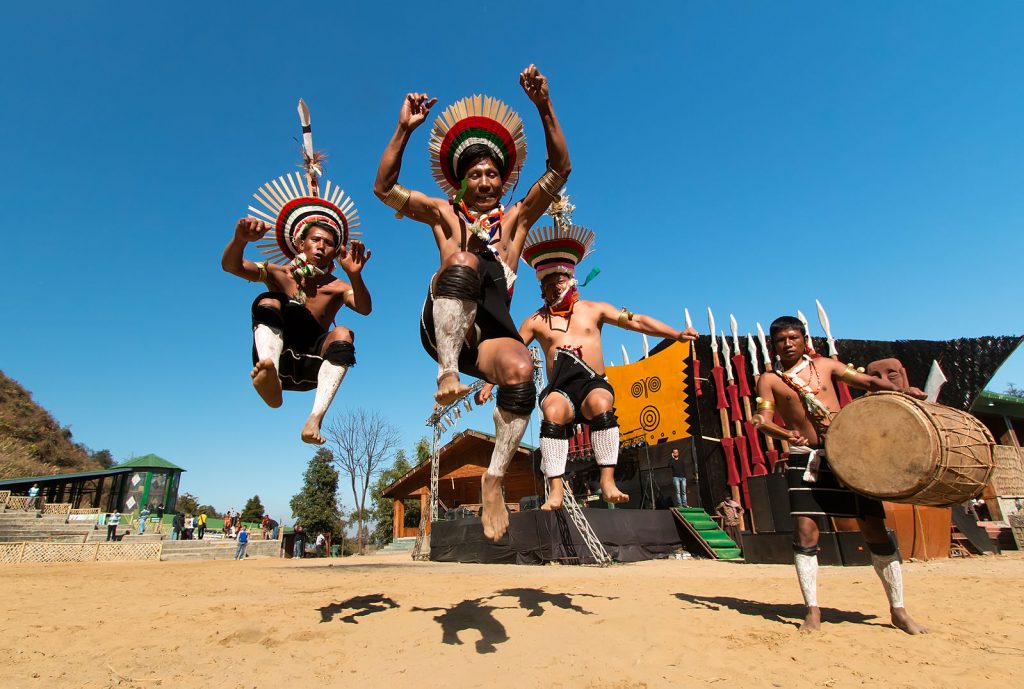In India, bonding often begins with a cup of tea. Whether it’s your morning brew, a mid-work break, tea with friends, or a quick cup from a local stall during a journey, tea is woven into the fabric of daily life. It is a thread that weaves together connections, conversations, and relaxation in everyday life. Our love for tea makes perfect sense—India is one of the largest tea growers in the world, making it a paradise for tea enthusiasts with different types of tea in India. A nation of over one billion tea drinkers, over 70% of the tea produced in India is consumed within the nation itself. In fact, other than cricket, tea is the one uniting factor for Indians and it transcends all boundaries and differences. If you’re one of them, you’ll agree: there’s no such thing as too much tea.
While masala chai might be your favourite, the realm of Indian teas offers so much more. The country boasts an array of flavours and types of tea in india that reflect its unique geography, climate, and cultural influences. In a country as diverse as India, there are several versions and names for a cup of chai in every corner, and the best way to explore these gorgeous vistas is by booking a cab. From ancient practices to contemporary fusions, our exploration of India’s tea flavours promises to leave you with a newfound appreciation for the artistry and diversity that grace our cups and enrich our lives.
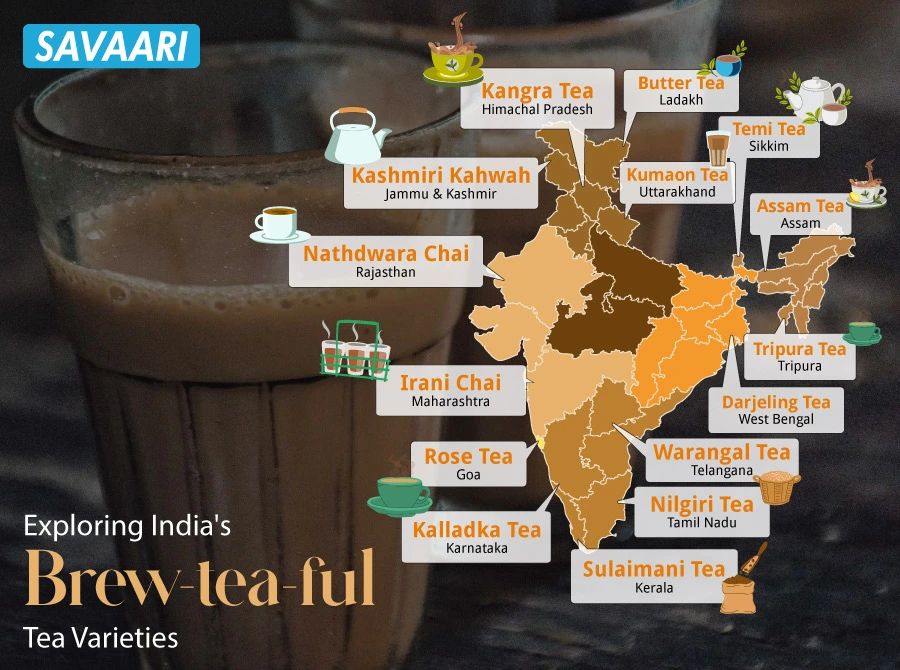
India’s tea trail – The journey of tea to India
Tea consumption in India dates back to 750 BC, with several legends about its discovery. It is believed that tea leaves were initially brought from China during the silk trade, although the Camellia sinensis plant grew naturally in the Assam jungle. Before being recognized as a beverage, tea leaves were used for diet, medicine, and flavoring dishes. A legend tells of an Indian king who discovered that boiling tea leaves helped him stay awake during long court meetings, thus popularizing tea.
The British formalized tea cultivation in India. In the late 1700s, Warren Hastings sent Chinese tea seeds to Bhutan for planting, but they struggled in Assam’s heat. In 1776, Sir Joseph Banks suggested using native plants. By the early 1800s, Robert Bruce discovered wild tea plants in Assam, leading to the development of the Assamica variety. The first shipment of tea from India was sent to England in 1823.
By 1840, India’s tea industry expanded to Kangra and Darjeeling, where Chinese seeds thrived. The success of native tea led to the establishment of numerous plantations across India. By 1874, there were 113 gardens covering 18,888 acres, producing over 3 million pounds of tea.
After the British left, India’s tea production continued to grow, making it one of the world’s largest producers. Today, there are over 13,000 gardens employing more than a million people with different types of tea in India. However, the significance of tea in India extends beyond its journey. Today, tea plays a crucial role in travel and daily life across the country with tea tourism in India picking up faster than ever and here’s how.
Brewed journeys – Where travel meets tea
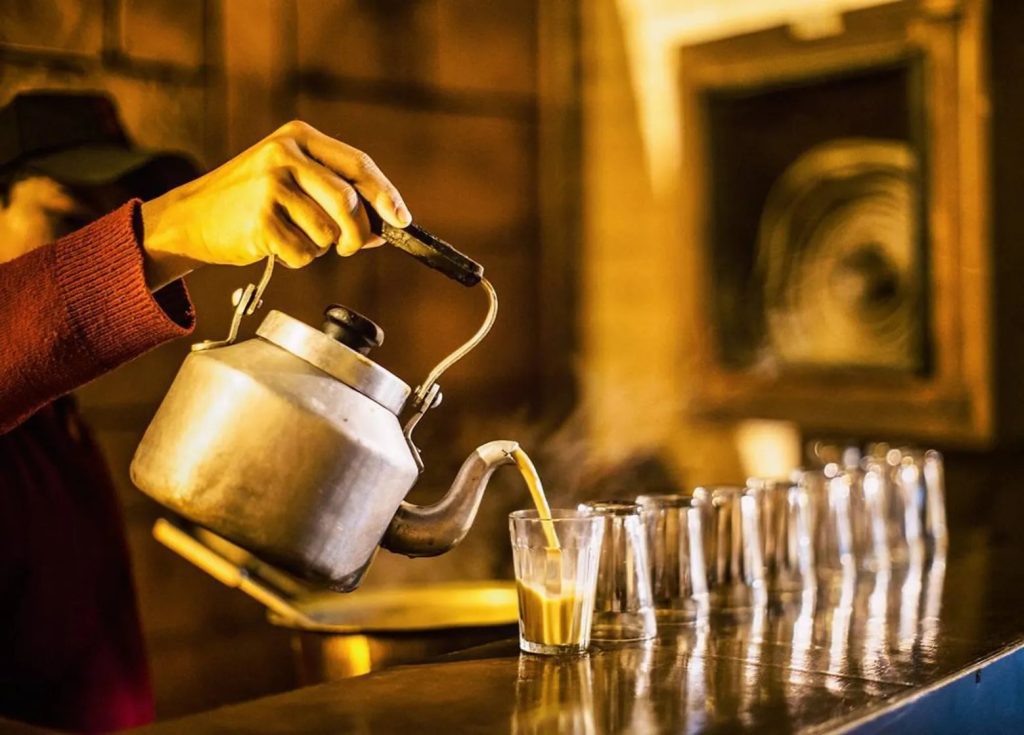
Tea and travel are inseparable companions, each enhancing the other’s charm. Imagine a road trip on a cold winter day, with tea as the fuel that keeps you going. As you wind through mountain paths, a steaming cup of tea warms your soul and refreshes your spirit. On a long journey, stopping at a roadside stall for a cup of tea can turn strangers into friends and make picturesque views even more enchanting.
There’s nothing quite like sipping a warm brew while soaking in breathtaking scenery from the window of your car. So, when travelling to these regions, instead of sticking to your usual masala chai, take the opportunity to sample the different types of tea in India and their distinctive tea flavours. Here are different tea varieties in India you can sample in different parts of India and where to find them.
India’s tea treasures – Different types of tea in India
1. Kangra Tea
Grown in one of India’s oldest tea-producing regions, Kangra tea is a unique type of black tea. This tea variety in India bushes thrive at altitudes of 4,000-6,000 feet on steep slopes, benefiting from plenty of sunlight and excellent drainage. The history of Kangra tea dates back to 1849 when Dr. Jameson, then superintendent of the Botanical Tea Gardens, identified the region as ideal for tea cultivation. As one of India’s smallest tea regions, Kangra’s green and black teas are particularly exclusive. The black tea is known for its sweet, lingering aftertaste, while the green tea has a delicate woody aroma. The cool, temperate climate of Kangra slows the growth of the tea bushes, allowing the leaves to develop a mild, delicate flavor often described as slightly floral or fruity.
Kangra Valley, located about 450 kilometers from Delhi, is perfect for an extended weekend getaway. However, the journey can be challenging due to rocky and gravel roads leading to remote estates. Booking a Savaari from Delhi to Kangra ensures a smooth trip with an expert chauffeur who will confidently navigate the terrain, allowing you to relax and enjoy the scenic drive.
2. Assam Tea

As one of the most popular teas in India, Assam tea is cherished both locally and globally. Originating from the lush green gardens of Assam, this tea is celebrated for its bold and malty flavor. Assam stands as the largest tea-producing region in India, accounting for over 50% of the country’s total tea production. Imagine fields spanning 304,000 hectares, all covered with tea bushes—a symbol of Assam’s extensive tea cultivation.
Assam tea boasts a rich history dating back nearly two centuries. When the British decided to cultivate tea in India, they likely didn’t anticipate that Assam would evolve into such a significant tea production hub. Initially, they brought tea plants from China, only to discover that a wild tea plant was already thriving in Assam, showing immense potential for cultivation. The region’s tropical monsoon climate provides the perfect environment for tea production, yielding a tea described as full-bodied and brisk. Assam tea is high in caffeine and possesses a deep reddish-brown color.
Traditionally, Assam tea is served without milk, highlighting its strong and robust flavor. Instead, locals often enhance their tea with sugar, lemon, or spices such as cardamom or ginger. Beyond its delightful taste, Assam tea is believed to increase mental alertness and may help prevent certain cancers, including lung and ovarian cancer. The best way to explore the flavors of Assam and visit the tea estates in the northeast is by embarking on a road trip. That’s why we’ve created the perfect North East India tea plantation itinerary for you.
3. Darjeeling Tea
Darjeeling, known for its picturesque views and pleasant climate, is world-famous for the diverse types of tea in India it produces and exports. The unique tea leaves from this region can be processed into various types, including black, oolong, white, and green tea. In the early 1800s, the British, heavily reliant on China for their booming tea trade, sought an alternative closer to home due to tense relations. With India under British control, the subcontinent became the focus of their tea experiments. They established a base in Darjeeling, leasing the land from the Kingdom of Sikkim for its strategic location near Bhutan, Nepal, and Sikkim. The area also became a popular tourist destination, offering British soldiers a cool respite from the Indian plains’ sweltering heat.
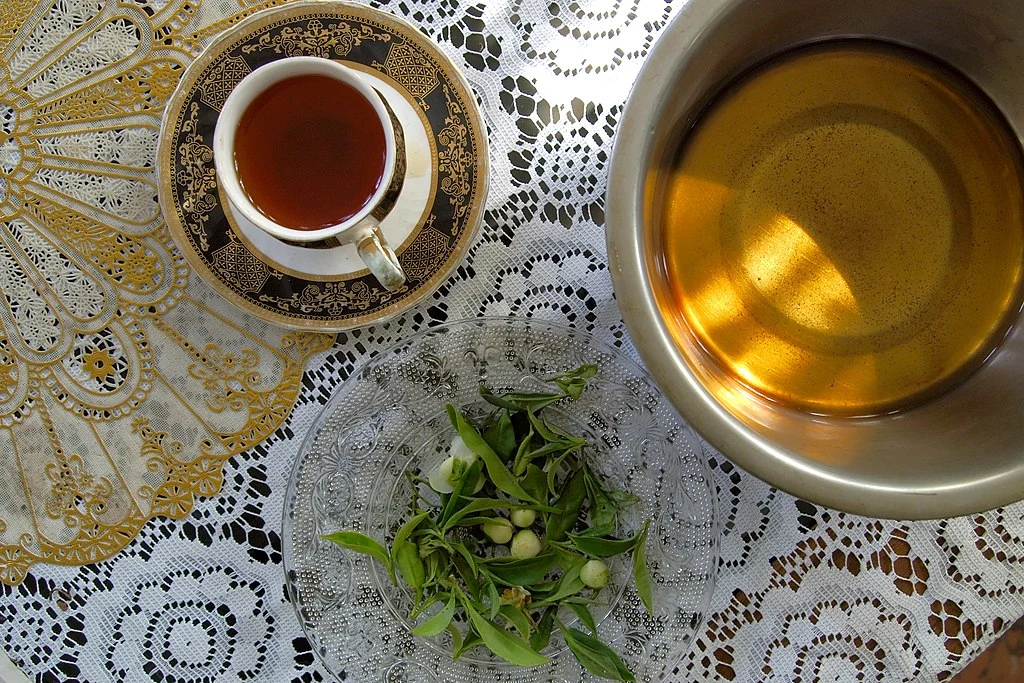
In the 1820s, the discovery of native tea plants in Assam led the East India Company to initiate a vast project to develop an Indian tea industry. Knowing the best teas grew in the mountains, the British superintendent of Darjeeling, Arthur Campbell, planted tea bushes in 1841, creating the first Darjeeling tea garden. Tea grown in Darjeeling is known for its thin, light body and floral aroma. It is celebrated for its health benefits, including increased hydration, stress reduction, high antioxidant content, and aiding in digestion by releasing toxins from the body.
4. Nilgiri Tea
Nilgiri tea, one of India’s most beloved and widely enjoyed teas, hails from the picturesque Nilgiri hills in Tamil Nadu. This tea has a rich history dating back to the late 1800s when it was first exported from its namesake district. Known for its unique flavor and aroma, Nilgiri tea benefits from the region’s high elevation and misty climate, which contribute to its distinctive taste, and is renowned for producing one of the rarest types of tea in India.
The Nilgiri hills were first identified by British explorers in the late 18th century as an ideal location for tea cultivation. By 1854, the British East India Company had begun establishing tea estates in the area, soon making it the largest producer of Nilgiri tea. Over the years, other tea companies have joined in, further popularising Nilgiri tea among enthusiasts. You can explore the tea gardens, learn about the tea-making process, and indulge in tea tasting sessions. Furthermore, there are several tea estates in the Nilgiris that offer a memorable tea tourism experience. This includes the Glendale and Chamraj estates. Book a cab from Bangalore to Nilgiris to travel and explore the tea estates in comfort.
Beyond its fascinating history, Nilgiri tea offers numerous benefits. Its delicate flavor and light aroma make it a perfect choice for those looking to avoid heavily caffeinated beverages. Rich in antioxidants, Nilgiri tea helps reduce inflammation and supports weight loss. Additionally, it is known to alleviate stress and boost mood, making it not only a delightful drink but also a beneficial one for overall well-being.
5. Kumaon tea
Nestled in the foothills of the northwestern Himalayas, Kumaon is often overlooked in the context of tea production. When the British introduced tea to India in the 1830s, they were initially attracted to the acidic, well-drained soils of Kumaon. Despite the plants thriving on the mountainous slopes, the region’s isolation posed significant challenges in transporting tea from the mountains to the ports, leading to its abandonment in favor of Assam and Darjeeling.
It wasn’t until the 1990s that the state government sought to create more economic opportunities for rural communities and turned back to tea cultivation. Abandoned lands with once-rich soil were leased from locals, old tea bushes were rehabilitated, and new organic ones were planted. Kumaon white tea offers maximum health benefits while providing a light, smooth flavor. The fresh Kumaon white tea leaves, handpicked at their peak, boast an exceptionally high level of antioxidants.
6. Temi Tea
The Temi Tea Estate, the sole tea estate in Sikkim, is renowned for producing one of the rarest types of tea in India and top-quality tea for the international market. The tea leaves are hand-plucked with care to offer tea lovers worldwide a delicious brew that is light, golden yellow, and delicately flavored. The lush green slopes and gradients of Temi Tea Estate are ideal for cultivating premium-quality black and green tea.
Green tea at Temi is crafted by bringing in delicate green leaves, which are then steamed, rolled, and dried, entirely without any pan-frying, ensuring the tea is 100% organic. Temi green tea, rich in antioxidants, offers numerous health benefits, including aiding in fat loss and lowering the risk of cancer. The first flush of tea leaves is picked during the spring season, yielding tea with a distinct flavor and scent, and a light yellow color.
When planning a trip to Sikkim, book a cab from Gangtok and make sure to add Temi Tea Garden to your itinerary. It is considered one of the best tea estates in the world due to its exclusive use of organic fertilizers and immaculate quality, attracting visitors all year round. The tea garden is beautifully lined with magnificent cherry blossom trees.
7. Tripura Tea
While Assam and Darjeeling often steal the spotlight, the tea estates of Tripura offer a unique story, rich in history and distinct flavors. Tripura’s tea story began in the early 1900s, a time when India’s tea scene was largely influenced by British interests. However, the Maharaja’s vision in 1916 set Tripura on a different path. Over time, tea became integral to Tripura’s economy and culture, providing numerous jobs and becoming embedded in the community’s way of life. Despite facing challenges such as labor shortages and the impact of India’s 1947 Partition, Tripura’s tea sector demonstrated remarkable resilience, adapting and growing over the years. Today, the industry remains a vital part of the state’s economy with a promising future.
The tea gardens in Tripura mainly produce CTC (Crush, Tear, Curl) tea and a smaller amount of green tea. Tripura’s CTC tea is celebrated for its bold and robust flavor, perfect for the rich masala chai that is a staple in many Indian homes. The unique CTC process ensures each granule is packed with full flavor, offering a deep and invigorating experience.
In addition to CTC tea, Tripura is also known for its Bamboo leaf tea. This tea, made from various bamboo species leaves, highlights the region’s creative use of its natural resources. Valued for its health benefits, such as aiding digestion and providing relaxation, Bamboo leaf tea is an organic option with numerous wellness perks, making it an intriguing choice for those looking to explore beyond traditional tea types.
8. Rose Tea
A royal colonial matrimonial alliance between Great Britain and Portugal played a significant role in shaping the tea culture in British India and Portuguese-held Goa. When Portugal’s Princess Catherine married Prince Charles II in the 17th century, her dowry included chests of tea, a gift that significantly influenced the people of England and laid the foundation for the cherished tradition of ‘afternoon teas’. This newfound passion for tea soon spread to Portuguese colonies, including Goa, where it left a lasting impact on the local tea-drinking culture.
Today, the people of Goa savor a distinctive tea called ‘rose tea’, infused with the delicate aroma of roses. This unique Goan offering is believed to possess soothing properties that aid digestion. Traditionally, rose tea is best when prepared with well water, enhancing its unique flavor and health benefits.
9. Kashmiri Kahwa
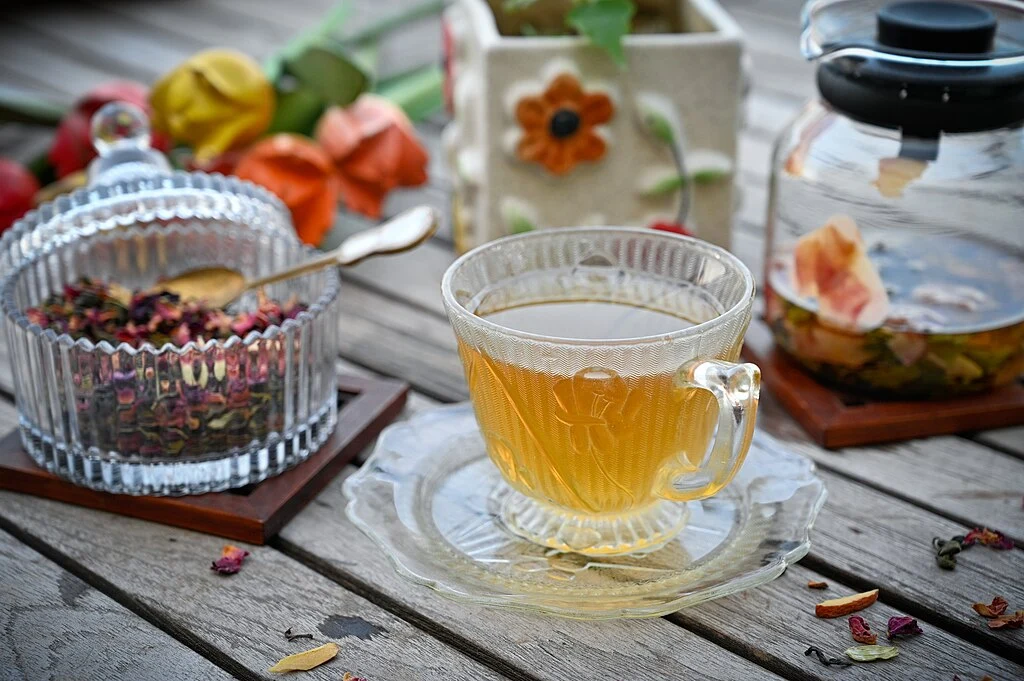
Kashmiri Kahwa tea is a cherished traditional beverage from the Kashmir region in northern India. Renowned for its unique flavor and aroma, Kahwa is a blend of delicate green tea leaves and natural ingredients like saffron, cinnamon, and cardamom. This combination creates a tea that is both refreshing and comforting, making it a favorite during the cold winter months.
Steeped in tradition and culture, Kashmiri Kahwa is often served at special occasions and social gatherings as a symbol of hospitality and warmth. The preparation involves a mix of traditional Kashmiri spices known for their medicinal properties. Saffron, for example, has antioxidant and anti-inflammatory benefits, while cardamom aids digestion and relieves nausea. Thus, Kahwa is not only a delicious drink but also a healthful remedy, valued in Kashmiri folk medicine.
Kahwa is also integral to Kashmiri cuisine, often paired with traditional dishes like Rogan Josh, Gushtaba, and Tabak Maaz. The tea’s aromatic profile, featuring cinnamon, cardamom, green tea, crushed almonds, cloves, and the special touch of Kashmiri rose, perfectly complements the rich, bold flavors of these dishes, creating a complete culinary experience.
Traditionally served with a drop of honey to enhance its sweet notes, Kahwa can also include ingredients like pistachios, apricots, pine nuts, and dried cherries. Some variations feature warmer elements such as walnuts, dates, and cashew nuts, making each cup of Kahwa a heavenly and unique experience.
10. Butter Tea
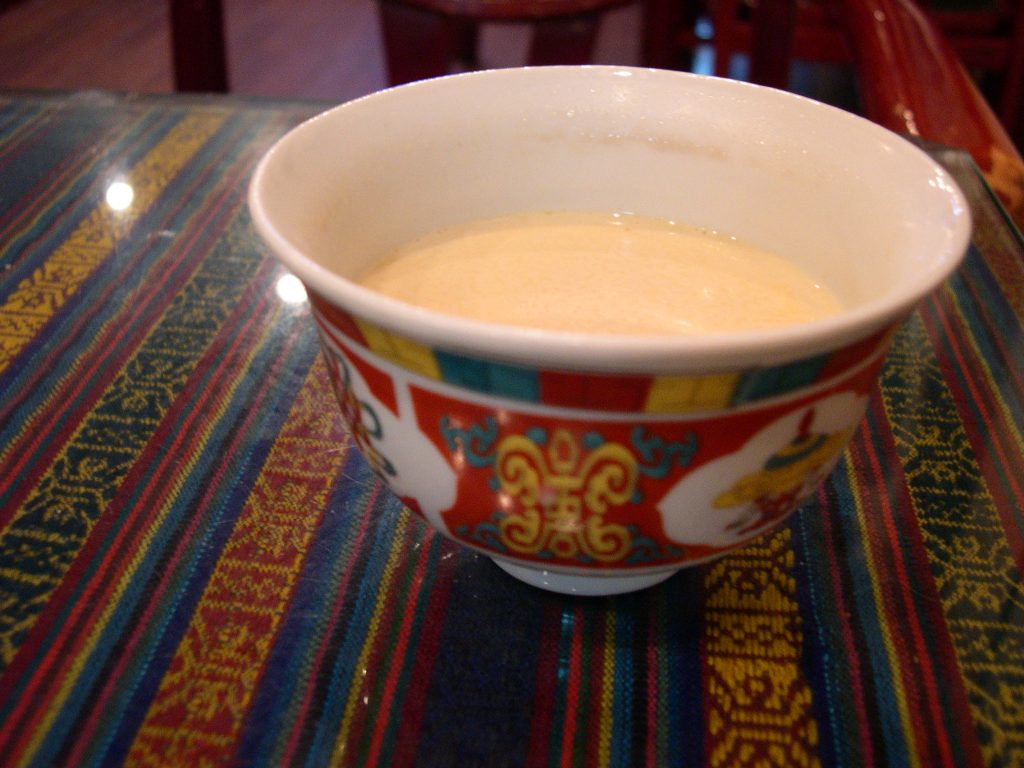
Butter tea, also known as “po cha” or “gur gur cha,” is a traditional beverage popular in Ladakh, Tibet, and Bhutan. This unique tea is made by churning tea leaves with yak butter, salt, and water until a frothy mixture is formed. The result is a drink with a distinctive taste—salty, slightly bitter, and creamy due to the butter. Traditionally served in small bowls, butter tea holds significant cultural importance, being an essential part of social gatherings and ceremonies in the region.
While butter tea may not be widely consumed in other parts of India, it is deeply ingrained in the cultural and culinary traditions of the Himalayan people. Its rich, hearty flavor and nourishing properties make it well-suited to the cold, high-altitude climates where it originates, providing warmth and sustenance. Enjoying butter tea is a must when going on a road trip to Leh Ladakh, following this carefully crafted itinerary.
11. Lebu Cha
Lebu Cha is far from your ordinary cup of lemon tea. This magical concoction from Kolkata marries the goodness of tea with the tangy twist of lemon and an array of spices known as “Moshla.” Infused with rock salt, cumin seeds, carom, and black pepper, Lebu Cha boasts a unique and refreshing flavor that sets it apart from regular chai.
Beyond its delectable taste, Lebu Cha is packed with health benefits. The spices not only enhance the flavor but also offer relief from coughs and colds and aid digestion. The inclusion of fragrant gondhoraj lemon or pati lebu adds a burst of freshness and a boost of Vitamin C, strengthening the immune system. Enjoying a cup of Lebu Cha is not just a treat for the taste buds, but also a natural remedy that promotes overall well-being.
12. Noon Chai or Kashmiri Pink Chai
Noon Chai, also known as pink tea, is a beloved traditional beverage from the Kashmir Valley in India. This unique tea is crafted using black tea leaves, milk, special spices like cardamom, cinnamon, cloves, and saffron, along with a specific type of green tea known as gunpowder tea. The addition of a pinch of baking soda gives the tea its distinctive pink color.
Served hot, Noon Chai has a creamy texture and a rich, savory taste with a slightly salty flavor. It is typically enjoyed during special occasions such as weddings, festivals, and other celebrations. The combination of aromatic spices and the striking pink hue make Noon Chai not just a drink, but a symbol of Kashmiri culture and hospitality.
13. Sulaimani Tea
Sulaimani tea, with its sweet-sour and slightly spicy flavor, adds a much-needed zest to an otherwise mundane day. The name Sulaiman, translating to ‘Man of Peace’ in Arabic, is fitting for this harmonious blend. It is said that Prophet Mohammed often enjoyed a beverage called ghava made with dates and black pepper. This drink gained popularity among Arabs, who adapted the ancient recipe to suit their tastes. Arab traders then brought the beverage to the Malabar coast of India, when the now-lost port city Muziris existed. This was where it was further modified by incorporating local spices and replacing dates with sugar. Eventually, tea was added to the blend, and it became known as Sulaimani.
The citrusy flavor of Sulaimani tea invigorates your senses, leaving you refreshed with every sip. Originating from the Arab world, Sulaimani tea has become a cherished part of the culinary tradition in India’s Malabar region and the aristocratic city of Hyderabad. Known for its sweet-sour taste and digestive properties, it is often enjoyed after a heavy biryani or a wedding banquet. The robustness of black tea is perfectly balanced with the tang of lemon and spices, creating a refreshing and soothing brew. Additionally, it is believed to help reduce cholesterol levels, promoting heart health.
14. Irani Chai
At one time, Irani chai was the cornerstone of café culture in Hyderabad, especially in the old city. Introduced by settlers from Persia, this unique beverage and the establishments serving it evolved into cherished institutions. Today, this teahouse tradition retains its strongholds around the old city, in small scattered bakeries, and in renowned restaurants like Garden Café and the legendary Paradise in Secunderabad. These places have large, fiercely loyal followings who begin their day with the traditional Irani chai.
The story goes that Persian immigrants arrived at Mumbai’s port in the last century, seeking better opportunities and trade prospects. From Mumbai, they migrated to Pune and eventually to Hyderabad, bringing with them the concept of Irani chai. This sweet, milky tea is known for its unique taste and rejuvenating properties. It is typically served in a white ceramic cup and saucer, often called 90 ml chai due to its standard volume.
Irani chai is traditionally enjoyed with staples such as Osmania biscuits, lukhmi, tie biscuits, fine biscuits, and even sweet cream. Today, there are plenty of Irani cafes in Mumbai that serve Irani chai with delicious food. This cultural heritage continues to thrive, offering a nostalgic taste of history with every sip.
15. Nathdwara Chai
Nathdwara, a town in Rajasthan located 48 kilometers northeast of Udaipur, is renowned for its temple of ShriNathJi. This special tea, prepared with generous amounts of ginger and fresh mint, is traditionally served in earthen cups known as kulhad, making it exceptionally refreshing. The flavors blend harmoniously, creating a unique and delightful beverage.
Nathdwara Chai is a popular offering among street vendors, who also sell a variety of snacks like poha, dhokla, vadas, and more. The street market in Nathdwara offers a wide range of delicious snacks, with this flavorful chai being a highlight for visitors and locals alike.
16. Kalladka Tea (KT)
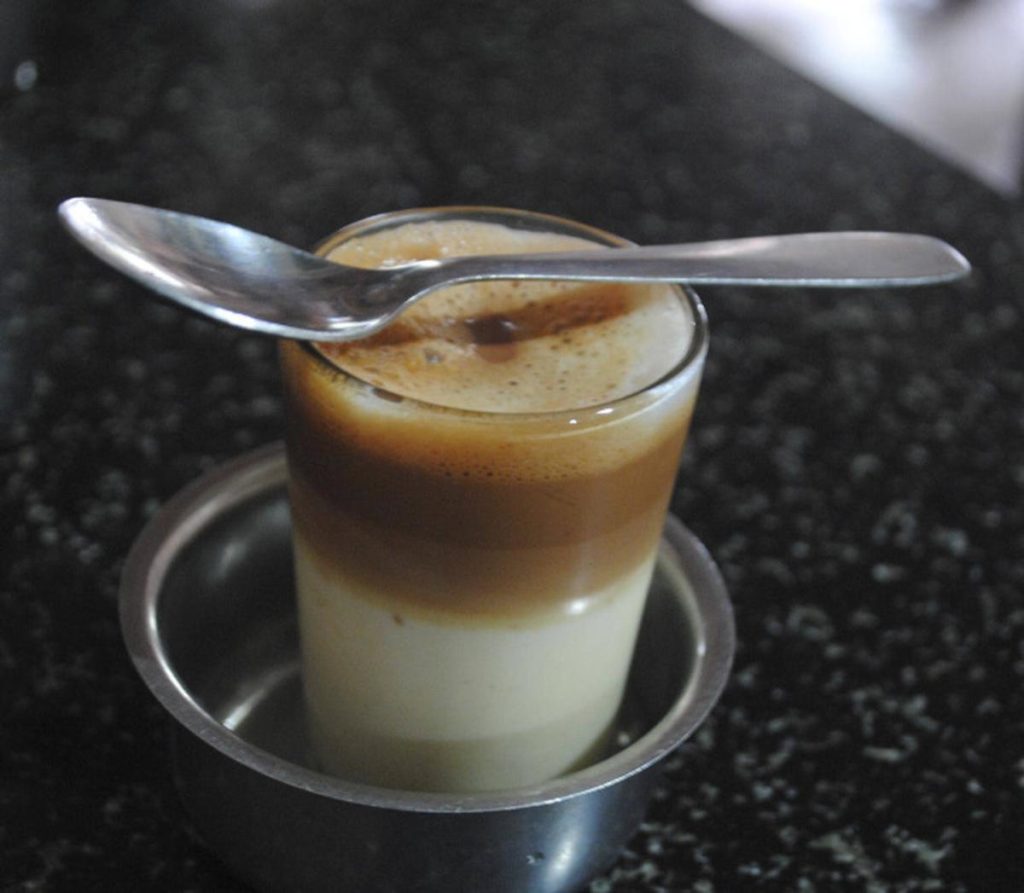
Remember the Dalgona coffee that became popular during the COVID-19 pandemic? Kalladka Tea (KT) is the original tea version of it. For many travellers passing through or near Kalladka on National Highway 48 (now NH 75) to Bangalore from Mangalore, a small roadside hotel at Kalladka junction is a major attraction, renowned for its food and unique way of serving tea and coffee. The almost worn-out Hotel Laxmi Nivas is a favourite pit stop for motorists on NH 75. Regardless of the time of day, stopping at the hotel to sip the aromatic and visually enticing KT is a must. While normal tea has a frothy milk cream layer atop the tea, KT features a one-fourth layer of thick tea decoction sitting atop thick milk. This unique preparation method gives KT its distinct appearance and rich flavour.
17. Lemongrass Tea
Known as “Sarvi Cha” in Hindi, lemongrass tea is a refreshing beverage suitable for any mood and occasion. It is typically made by blending lemongrass with other ingredients like mint or ginger. Packed with antioxidants, vitamins B1 and B2, and anti-inflammatory properties, it is excellent for fighting colds and maintaining overall health.
The lemongrass grown in the western Himalayas is particularly fragrant, with a pleasant floral aroma. To relax and rejuvenate, enjoy antioxidant-rich lemongrass white tea, which combines the therapeutic benefits of white tea leaves with the soothing properties of aromatherapy.
The art of selecting India’s finest teas
Determining the best tea in India involves evaluating several key factors, including flavor profile, aroma, appearance, and the regional characteristics of each types of tea in India. Here are some considerations to help identify the best tea:
- Geographical elements: The region where the tea is grown significantly influences its flavor and quality. Factors such as soil composition, climate, and altitude contribute to the unique characteristics of the tea.
- Altitude and seasonal variations: High-altitude teas, such as those from Darjeeling, tend to have more complex flavors. Seasonal variations, including first flush, second flush, and autumnal teas, also affect the taste and aroma.
- Traditional processing methods: The methods used to process the tea leaves, including withering, rolling, oxidizing, and drying, play a crucial role in developing the tea’s final flavor. Different types of tea in India, whether it be oolong, black, green, or white, undergoes specific processes that highlight its unique qualities.
- Oxidation levels: The degree of oxidation affects the flavor, color, and strength of the tea. For instance, black tea is fully oxidized, giving it a robust flavor, while green tea is minimally oxidized, resulting in a lighter, more delicate taste.
- Cultural context and authenticity: Understanding the cultural significance and traditional practices behind each tea can enhance appreciation. Authentic production methods and the tea’s historical background contribute to its overall value.
- Flavor profile and aroma: The best tea should have a well-balanced flavor profile and a pleasant aroma. Tasting notes can range from the robust spices of masala chai to the delicate floral notes of Darjeeling tea.
Why go on a tea exploration road trip with Savaari?
Tasting teas in India is more than just a culinary experience; it’s a flavorful journey that takes you through the diverse landscapes and cultures of the country. The best way to truly appreciate this journey is by embarking on a road trip. Every nook and corner is infused with the aroma of different types of tea in India wafting through the air, creating an inviting atmosphere for travelers. By booking a Savaari car rental through the app, you can easily fuel your energy and discover the rich realm of Indian tea.
Whether you’re navigating the bustling streets of a city, exploring a mountainous tea estate, or simply stopping by a roadside stall to satisfy a tea craving, each sip tells a story of the region’s unique heritage. This journey is not just about tasting different types of teas in India, but about immersing yourself in the traditions and landscapes that make each variety special. It’s about meeting the people who have dedicated their lives to perfecting the art of tea-making and understanding the cultural significance of this beloved beverage. So, set out on a road trip across India, and let the diverse flavours of tea guide you through a journey of discovery and delight.
Last Updated on June 8, 2024 by Shabari Shankar




